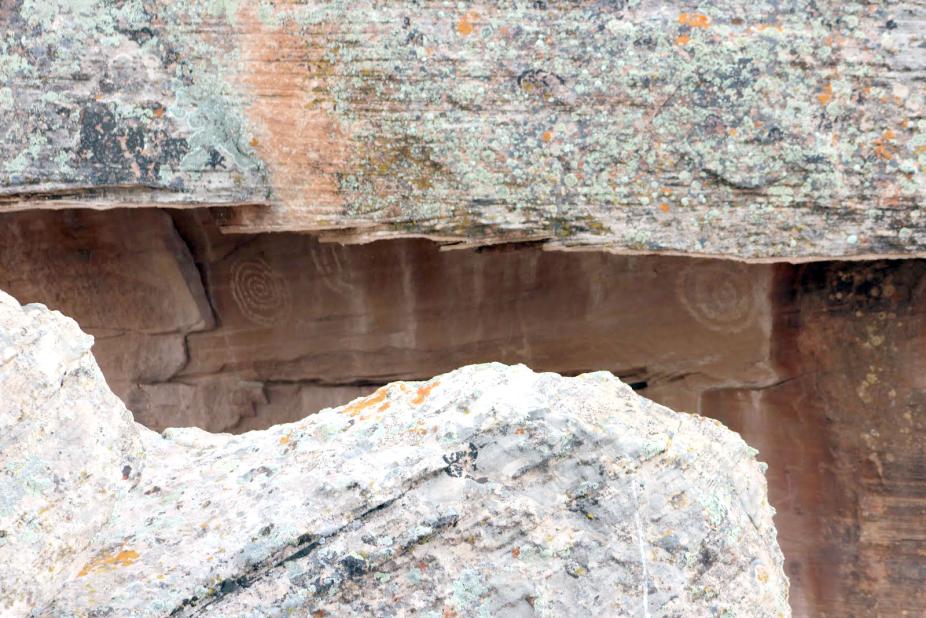Solar Symbol Petroglyph
While the ancient southwestern cultures have left no written records in the usual sense of the word, they have left a lot of rock art. Rock art can be broadly divided into petroglyphs, designs pecked or incised directly in the rock, and pictographs, designs painted on the rock using various naturally occurring pigments. Many different types of designs can be found: animals, anthropomorphs or "spirit" figures, handprints, human or animal footprints, geometrical figures such as spirals and concentric circles, as well as more complex abstract designs. Some of these designs are also found in petroglyphs dating from the Bronze age in Europe and Asia, while other patterns seem to be specific to the American Southwest.

A row of three petroglyphs have been pecked on the smooth, nearly vertical face underneath the overhanging ledge of the larger boulder.
Interpreting rock art is a very difficult task. Even the obligatory starting assumption in such an endeavor, namely that rock art represents a form of message or record with a well-defined information content, is open to doubt. Once again contemporary Pueblo cultures can in principle provide some relevant interpretations. This is not as easy as one might imagine, because many rock art sites and symbols evidently carry religious or spiritual significance, which modern Pueblo people are usually reticent to discuss with outsiders. The situation is further complicated by the fact that, as noted with a measure of dismay by some anthropologists, different "informants" from the same pueblo sometimes offer widely differing or even contradictory explanations as to the meaning of a given petroglyph.
Perhaps even more worrisome, some informants have been known to offer very distinct interpretations when queried by different anthropologists, or even when queried by the same anthropologist on different occasions. This should by no means be interpreted as bad faith on the part of the informants. It most likely reflects the fact that in Pueblo cultures, the meaning of rock art lies as much with the viewer as with the actual physical design on the rock. In light of this interpretational fluidity, it is impossible to ascertain whether the meaning suggested by modern informants has anything to do with that intended many centuries earlier by the creators of the rock art—if any well-defined meaning was intended at all. Nonetheless, the cultural context offered by modern Pueblo people remains an essential reference point.
Holly House ruin is yet another outlying site at Hovenweep National Monument. About 100 meters South of Holly House are two large boulders, the taller one with an overhanging ledge form an East-West oriented "tunnel" closed at its West end by a third large boulder. The photograph here shows a view looking approximately North, directly above the first boulder at the second boulder. A row of three petroglyphs have been pecked on the smooth, nearly vertical face underneath the overhanging ledge of the larger boulder. The leftmost petroglyph is a spiral; next to it to the right is a second, much faded spiral. Both spirals are about 30 centimeters in diameter. On the far right, about one meter away near the East opening of the tunnel, is a small solid dot framed by three concentric circles. This design is consistently interpreted by modern Pueblo people throughout the Southwest as a Sun-symbol.
Concentric circles are commonly found in locations that can be identified as Sun shrines or, less frequently, Sun observing stations. The spiral design, on the other hand, is usually not identified as a Sun-symbol by modern Pueblo people, although we are encountering it here (as well as in slide 12, Solstice Marker) in a context that is unambiguously solar. This may represent one example of the multiplicity of meanings of rock art, or meaning evolving through time.